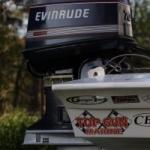
Originally Posted by
champ20B

You would need to rig up an oiling system, separate. It would require regular auto engine oil. You could probably do this with a diaphragm pump as long as the oil is cooled by a separate water jacket as it is recirculated or use an electric fuel pump. Also, it would not be a bad idea to cool the induction between the turbo outlet and intake with a water jacket as well ( intercooling system ) to densify the charge.
The early Detroit diesels that trucks and other industrial applications used were two cycle. They had a roots type blower that pressurized the engine intake. When the piston reached bottom, the pressure would scavenge the cylinder while the exhaust valves opened briefly. Then the valves shut and compression took place. When the compression was maxed, a mechanical injector sprayed fuel in and combustion occurred ( no glo- plugs. it cranked under compression alone!). Later on, a exhaust driven turbo was added to the blower for better power, which proves that a turbo can be driven by the brief action of two cycle exhaust.......


 Thanks:
Thanks:  Likes:
Likes: 



 Reply With Quote
Reply With Quote

Bookmarks